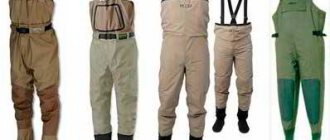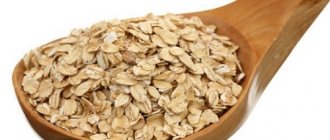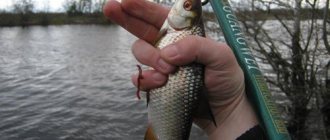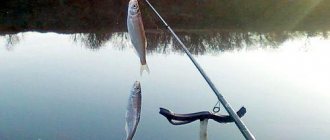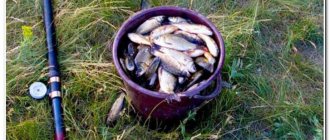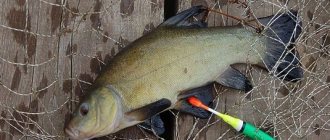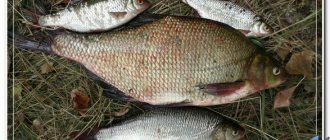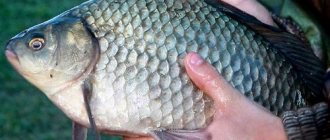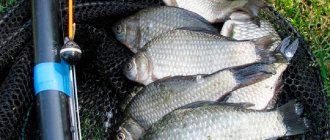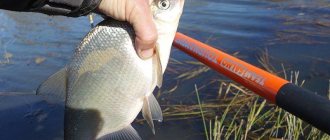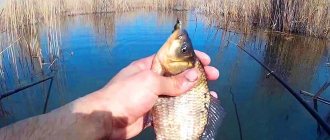Trout is a fish that is of great interest to many anglers. This is due both to the stubborn resistance of even relatively small specimens and to the taste of the meat. Spinning or fly fishing is more common, more often in paid reservoirs, less often in wild conditions. However, expensive specialized gear is not a necessary condition; fishing for trout with a float rod is sometimes even more effective, without requiring any highly specialized tools, as, for example, in a spinning rod (trout rods are not very well adapted for pike or perch) .
Selecting a location
You need to know in advance where you will be fishing. The choice of gear depends on this. Trout feed where it is easiest for them to find food.
You need to look for it:
- in the pits;
- in snags;
- near trees lying in the water;
- under high steep banks;
- under tree branches hanging over the pond;
- above and below the rifts;
- in places where the course of the river narrows and the flow accelerates;
- at the boundaries of direct and reverse flow;
- behind the boulders lying in the river bed.
The colder the water, the more likely it is that fish will feed in shallow water. In summer, when reservoirs warm up well, trout prefer to stay in the depths or under branches hanging over the water, since they do not like heat.
Choosing a place for fishing
How to catch trout using a spinning rod
In the case of paid ponds, there are no special problems with choosing a fishing location, since such reservoirs rarely have any significant, prominent relief features, and the fish are distributed more or less evenly. However, in such situations it makes sense to look closely at even the slightest anomalies at the bottom. Small holes, changes in depth, snags on the bottom or thickets of aquatic vegetation - fish can stand near all these places.
The situation is somewhat different in the natural habitat of trout. Here you often still need to look for fish. Most often, trout can be found near steep banks with great depths at the very feet, holes at turns in the river bed, in places where the river narrows and the current intensifies, near trees that have fallen into the water, as well as behind large boulders located in the current.
Important! On a bright, sunny day, you should not look for this fish where direct sunlight falls on the water. The most promising areas will be those areas that are in the shade of trees. Bait for trout fishing
For trout, since they are predatory fish, almost any bait of animal origin will do. However, she also has certain preferences. The likelihood of successful fishing is highest if you use as bait what is the basis of the fish’s diet in natural conditions. In the case of fish that live in mountain rivers, these are amphipods. Small, shrimp-like body shapes, crustaceans can be found under stones and in other similar secluded places. And also trout quite actively take on red dung worms, maggots and all kinds of larvae.

Amphipods are part of the trout diet in natural conditions and often show good results as bait.
Separately, it is worth mentioning the trout paste. This mass, which consists of flavoring and aromatic additives and has a consistency similar to plasticine, is produced by quite a few companies. It is easy to use - just form a bait out of it and attach it to the hook, and thanks to its strong aroma and bright color, it is also quite effective, especially when fishing in still waters, where the smell plays a slightly larger role than in current conditions.
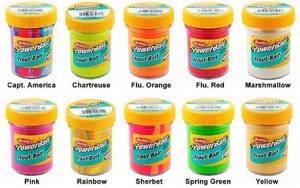
Trout paste has many options for color, taste and smell, which allows you to choose the option for a specific body of water.
Gear selection
Any type of float rod is suitable for trout fishing. The most commonly used are fly, Bolognese and match tackle.
Fly fishing rod
The swing is a simple float , in which there is nothing superfluous. The rings, reel seat and reel are missing. Thanks to this, the weight of such a fishing rod is minimal, and it is very convenient to fish with it.
For trout fishing, fly rods 4–7 m long are suitable. Which size to choose depends on the conditions. For fishing on a small river, a short fishing rod is better, especially if the banks are covered with trees and bushes that interfere with fishing.
If the reservoir is large and the banks are open, you should take a more serious fishing rod - 6–7 m long or more. With such gear it will be possible to cast the bait further, and the chances of a good catch will increase.
Bolognese fishing rod
The lapdog is the best fishing rod for trout . It consists of a telescopic rod 4–8 or more meters long, equipped with guide rings and an inertial or inertial-free reel. The Bolognese fishing rod is designed for fishing in the current; it is convenient to make long retrieves with it. To do this, you just need to send the equipment into the water and release the line from the reel.
The Bolognese fishing rod is equipped with an inertial or inertial-free reel. The inertial action is suitable for line fishing, but you won’t be able to cast light equipment far with it. The inertia-free reel, in turn, allows you to both comfortably fish with the wire and make long casts. It provides the fisherman with maximum opportunities.
Match fishing rod
Match – designed for long-distance fishing . It consists of a rod equipped with guides and a spinning reel. You can fish with a match and in a retrieve, like a lapdog, but for this it is much less suitable.
A match fishing rod is an excellent tackle for trout fishing on ponds and lakes, when you need to cast 15–20 meters or more. With a good match, you can easily fish 40–60 meters from the shore, where fish, including trophy ones, are always kept.
Rod selection
Although fishing for trout with a fishing rod with a float rig does not require any specialized variants of this gear, a number of features of both the behavior of this fish and its usual habitats are still worth taking into account when selecting a fishing rod. Thus, for trout fishing in the natural habitat of the fished object, match rods are poorly suited, since they are not designed to work in conditions of strong currents, however, on pay zones, which are most often ponds of different sizes with calm water, this tackle can perform well .
Fly fishing rod
Fishing for trout with a float does not necessarily require expensive match or Bolognese gear. For this fish, the most ordinary fly rod, approximately the same as those used for spring crucian fishing, is quite suitable. There is nothing superfluous on the form: a reel with a reel seat, guides, thanks to which fly rods are light, especially if made of carbon, and you can fish with them all day long without getting too tired.
Important! In the case of trout, it is still worth paying extra attention to the action of the rod - for this strong, actively resisting fish, slow blanks are more suitable, which dampen strong jerks.
The length of the rod depends on the fishing conditions. If this is a small mountain river, where it is difficult to approach the water behind continuous thickets, and low-overhanging tree branches interfere with casting, you should limit yourself to options up to 3 meters in length. If you plan to fish on a paid reservoir, which for the most part has clean banks and enough space for casting, preference should be given to 4–5 or 6 meter options. Longer models, which, although rare, are found on sale, are not the best choice, since fishing for a long time using such a fishing rod is tiring; for long distances it is better to choose a lapdog or matcha.
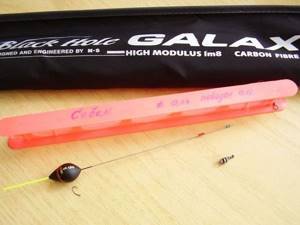
The equipment for the fly rod must be transported separately, on a special reel.
fishing line
Monofilament is usually used as the main fishing line for trout fishing. Suitable diameter is from 0.2 to 0.25 mm. For match fishing with long casting, a thicker monofilament with a diameter of 0.25-0.3 mm is sometimes used as the main fishing line, especially in cases where heavy waggler floats are used and long casts are made over several tens of meters.
There are special match monofilaments. They differ from standard ones in that they have little stretch and sink quickly after casting. Catching trout with such lines on a match rod is much more convenient than with a regular monofilament.
Leaders are made of monofilament or fluorocarbon with a breaking load 15–25% less than that of the main line. The best choice would be fluorocarbon. It has a refractive index close to that of water. Therefore, fluorocarbon is almost invisible to trout in the water. In this parameter it is superior to monofilament.
If you use fluorocarbon line leaders, the number of bites increases.
Trout winter fishing rods
Choosing a winter fishing rod is not an easy task, especially for novice anglers. There is a huge range of diverse fishing rods on the market, each with its own features and specific application. To always be with a catch, you need to choose the right winter trout fishing rod.
Fishing rod for trout from ice
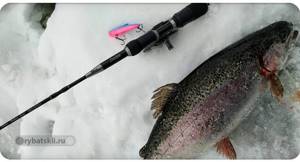
Considering that ice fishing with metal bait requires dynamism, constant transition from one hole to another, and frequent animation, you need to choose gear for trout fishing with a spinner based on the following characteristics:
- Relatively light weight. If you use a heavy rod, then in the process of trolling your hand will quickly get tired, the retrieves will be of poor quality, and the hooks will be less successful. In addition, tedious fishing will be further overshadowed by the presence of errors in fishing for trout.
- Tool length. Depending on the fishing technique and fishing conditions, the length of the fishing rod is in the range of 50–120 cm. For trout fishing, it is optimal to use fishing rods up to 50 cm, and for hunting pike and pike perch – from 50 cm.
- Handle material. Only a comfortable handle makes it possible to effectively retrieve the bait, informing even the careful touching of the fish. Handles made of cork, polystyrene foam, and PVC are particularly practical and comfortable to use. To choose the most successful option, you need to test a specific model in a store by picking it up in your hand and performing several sharp movements up and down. This animation will quickly attract a spotted predator. It is better to choose those fishing rods that fit well in your hand, do not slip, and do not turn.
- Whip. You can catch and handle trout only with a stiff rod. If you use soft options, then during the swing they will bend under the load from the bait. The result is weak animation.
- Fishing rod quality. Considering that the rod is under load when trolling, it must have a sufficient margin of safety.
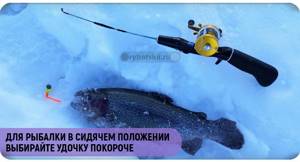
Another point that you need to pay attention to is the position of the body during the fishing process. If the hunt is carried out while sitting at the hole, then it is ideal to use short fishing rods with a hard whip and a short handle. If trolling will be done while standing, then it is optimal to choose long fishing rods with a medium-fast action.
To ensure that a fishing rod for trout fishing in winter on a platform does not fail during important actions, the reel seat must be as reliable as possible. There should be no spontaneous unwinding. When fishing in the cold, a plastic mount that does not freeze when in contact with water works best.
Trout on the nod
A rod for winter trout fishing with a nod is an excellent option, especially when the predator is inactive. Thanks to the flexible whip at the end of the fishing rod, the angler can respond to a bite in a timely manner and more effectively bring the prey to the surface.
Fishing rod rig
Standard equipment for trout fishing with a float looks like this:
- the float itself, which is attached using one or more cambrics;
- several pellet sinkers of different sizes, located on the fishing line in descending order: the largest is closer to the float, the smallest is below;
- leash with hook.
In addition to standard equipment, you can also use installation with two leashes and hooks. The first one should be higher than the second one. In this case, it will be possible to fish different horizons with one fishing rod and quickly determine at what depth the trout are kept on the day chosen for fishing.
To fish with a match fishing rod at great depths exceeding the length of the rod, you need sliding equipment:
- a locking knot is tied on the fishing line;
- then the bead is put on;
- after it - a sliding float;
- another bead;
- then sinkers and a leash with a hook are attached to the fishing line.
Clothing and equipment
Waders
In many cases, wading boots or waders are an indispensable piece of equipment for trout fishing with a line. In them you can go into the water at a distance of 5–10 or more meters from the shore. This will be especially useful when fishing with a fly rod, when it is not possible to make a long cast. But wading boots or waders will also be useful when fishing with Bolognese or match gear. Thanks to them, catches increase significantly.
Landing net
Also, when fishing for trout with a fishing rod, a landing net is useful. This fish is very slippery, and it is inconvenient to handle it with your hand. The landing net is selected according to the fishing conditions . For fishing with a float rod from the shore, landing nets with long handles are suitable, which can be used to catch fish even if the shore is high or thickets of grass are in the way. For wading fishing, compact landing nets called “rackets” are used. When such a landing net is not used, it can be hung behind your back and it will not interfere with fishing.
It is better to choose a landing net with a silicone mesh. The hook will not get stuck in it, it does not absorb odors, and it is always easy to clean. The silicone mesh does not injure the delicate skin of the trout, which is important for those who fish using the “catch and release” principle.
Fishing for trout with a fishing rod
Trout in rivers can be effectively caught with a Bolognese fishing rod using special equipment and special fishing methods. As well as artificial imitation baits designed for trout fishing. The famous fisherman Marco Mariani believes that it is more advisable to catch trout with artificial bait, especially in the spring, and shares his fishing experience...
Special lures for trout
Artificial baits that imitate the natural food of brook trout are beneficial for catching them. We are talking, first of all, about silicone fake salmon caviar, as well as about imitation of small fry. Artificial baits hold the hook very well and can be used to catch several fish. While natural ones are almost impossible to use, they are so weak and fall off the hook.
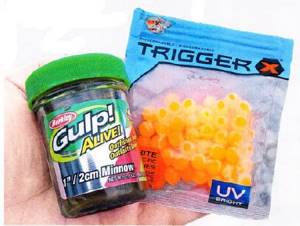
Marco Mariani also claims that no difference has been noticed in the catchability of natural baits and their imitations made at the modern level. It is possible that the trout does not have time to distinguish a fake, since it attacks with lightning speed in a fast current. In general, it is more advisable to catch trout using artificial bait.
One of the rules of trout fishing is that the fish must be given the food that is in the pond. If you offer beetles and insects to trout in cool water in the spring, it will not perceive this food as natural. At this time, it is better to catch trout with what they can actually feed on. But the choice is not great - either salmon caviar, or very small fish - only 2.5 cm long, imitating newly hatched fry.
Rod and reel
The naturalness of the bait is not as important as the way it is presented. Therefore, special attention must be paid to the installation of equipment and its correct use.
The rod used is light, 7 meters long. The large length makes it easy to adapt to conditions and fish larger water areas.
Together with a Bolognese fishing rod for trout fishing, it is better to use an inertial reel, with which it is easy to make retrieves. It is also convenient for her to apply the necessary braking with her finger when fishing for small fish on delicate equipment.
Good models of wire reels for trout fishing are equipped with a rotating mechanism at the attachment point, which makes it possible to make long casts with inertia-free line release. Also, inertial reels should have a built-in gearbox, with the help of which the equipment is removed from the water very quickly. A good inertial reel for a Bolognese fishing rod will help when fishing for trout.
Trout fishing equipment
Hooks are selected in the usual shape with a smooth bend and a short shank No. 10 for fry and No. 12 for caviar.
The fishing line should not restrict the movement of the bait in the water. Therefore, a soft fishing line no thicker than 0.16 mm is used. Also, to give the bait a natural play on the stream, the trout hook is secured with a micro-supply fastener. You can do without a leash and tie a hook at the end of the main line.
A regular float is used with a fishing line attached in 2 places with a round buoyant body, which provides sufficient stability for fishing in the current.
The weight of the load is selected under certain conditions. Usually in the range of 2 – 5 grams. It is important that the hook does not rise too much under the influence of the force of the current when the wiring is slowed down. A load of many pellets is offered, which are located along 0.8 meters of the main line.
The last pellet should be located at a distance of 25 cm from the hook if normal downstream wiring is performed.
And 35 centimeters - when the equipment is held in weight using the Tosso method.
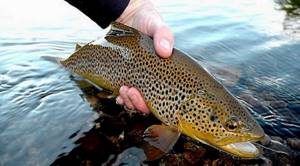
Trout fishing is a special kind of fishing, you need the appropriate gear and...
Techniques for catching trout in rivers
It is important to combine two fishing methods, but using the same gear. Then you can quickly adapt depending on the conditions, the topography, and quickly fish virtually the entire water area of small trout rivers.
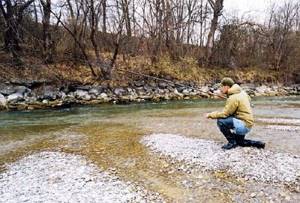
When you need to fish at close range, the float rises higher along the line and actually serves as an indicator of the direction in which the equipment is located. The fishing line is held by hand, adjusting the depth of immersion, and the bite is felt using the “touch” method.
Using this method, you can very accurately lower the bait behind rocks, in places with reverse currents, etc. just where trout usually wait for prey.
When nearby places are fished using the Tosso method, you can send the float to drift. But you need to remember to move the pellets and change the distance from them to the hook by 25 cm so that the action of the bait turns out natural. Wiring will allow you to fish other places in the river, with promising trout spots that cannot be reached by direct lowering. The wiring distance can be limited only by the visibility of the float on the water - and this is 30 - 35 meters.

It is important that the equipment is sensitive to the given conditions on the river. The float and load are selected according to the minimum principle, so as not to roughen the tackle. Also, the float, for a given current speed and depth, must be optimally loaded, which often has to be adjusted when fishing, depending on the conditions. There should be one antenna above the water that is sensitive enough to detect any bites.
In the spring, the trout are deeper, so at the opening of the season, the appropriate places are chosen. But the bait should not be presented at the very bottom - it’s better a little higher, then the trout will react more actively.
It is especially important to alternate fishing methods “by touch” and “by wire” in the spring, because fish sites change over the winter, and new ones need to be discovered; there may not be trout on old ones. Search and persistence will help in catching trout.
Lure
When fishing on paid platforms, feeding trout gives good results. You can use regular mixtures for catching white fish, such as crucian carp or crucian carp. Use those baits that are used when catching them in cold water, in spring or autumn. These mixtures contain animal ingredients such as fish meal or chopped fish. They attract trout well.
When fishing on platoons, coarse-grained mixtures, similar to the food that trout are given in such ponds, work well. You can use the feed that the fish are used to eating. This bait should be crumbly so that the granules do not stick together and fall apart from each other. During fishing, constantly throw in new portions to keep the trout at the fishing point. This fish is attracted to moving (falling) bait .
Lures
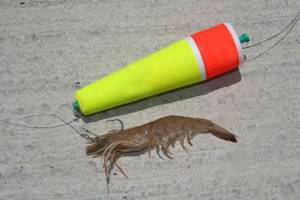
The following baits are used for catching trout using a float rod:
- worm;
- bloodworms, maggots and other insect larvae;
- shrimp;
- fry;
- corn;
- trout paste.
It is better to place bloodworms and maggots on the hook in bunches. In this case, there will be a greater chance that trophy-sized trout will be interested in the bait. In some reservoirs, this fish is excellently caught using live bait (fry), in others it pays almost no attention to such bait. A good live bait for catching trout near the surface and in the middle layers will be a verkhovka. You can use another fish of suitable size.
If you are going to catch trout with a fishing rod in an unfamiliar body of water, it is worth making inquiries about what baits it prefers in this water area. If you fail to collect such information, take as many attachments as possible and try them one by one.
Paste is a special bait for trout fishing, which can be bought in fishing stores. Its composition is selected in such a way that it perfectly attracts this fish.
If used sparingly, one jar will last for a long time, so this bait will not cost much.
Hooks
Hooks should be used No. 6-9 and only if large trout are caught, hook No. 3-5 can be tied. It is recommended to catch trout on a single-hook rig, as using a second hook can significantly reduce the number of bites due to the wariness of this fish.
You shouldn’t skimp on hooks, they should be sharp and strong, so you should give preference to trusted manufacturers:
- Owner;
- Cobra;
- Gamakatsu;
- Kamatsu et al.
If you plan to fish with paste, it would be advisable to buy special hooks with a spring on the fore-end. This spring helps the bait stay on the hook much better and longer.
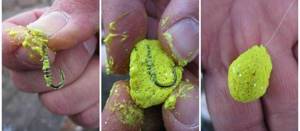
That's basically all that concerns float gear for trout fishing. There is nothing special about the equipment; you can even use the same fishing rod that you use to catch crucian carp. But you will still need lighter tackle, since the rod has to be suspended almost all the time - trout bites are very sharp and you need to always be ready to hook.
Choosing the time to catch
The timing for fishing for trout with a fishing rod depends on the season:
- in spring it is caught throughout the daylight hours, especially good catches can be obtained in the afternoon, when the water is warmed up;
- in summer, trout are active mainly in the mornings and evenings, as well as at night; in the middle of the day at this time the water warms up too much and the fish feels uncomfortable;
- In autumn , trout bite throughout the daylight hours.
Fishing technique
Ways to animate bait
Trout prefer moving bait . Therefore, when catching it with a fishing rod, the bait on the hook must, one way or another, be animated so that the fish becomes interested in it.
On the river, you just need to throw the equipment downstream, and the flow of water will do all the work for you. When the bait swims past a hungry trout, it will grab it. You can periodically make pauses so that the progress of the equipment slows down.
If there is wind on a fishing day, it will slowly move the float, and with it the equipment. They help animate the bait and waves. When there is excitement on the surface of a river or lake, the float rises and falls over and over again, setting a peculiar game for the hook with bait.
If there is no current, no wind, no waves, you will have to do all the work yourself. In such a situation, perform light pulls with the rod so that the bait moves from place to place. Trout that does not respond to a stationary bait will attack the bait floating in the water column and get hooked.
Another option is fishing with a falling bait. The sinkers must be moved higher towards the float, and then cast after cast to one point after another. Once in the water, the hook with bait will slowly sink, attracting fish. Sometimes, when the trout is capricious, it can only be enticed to bite in this way. Therefore, take it into service and use it if necessary.
Fishing of different horizons
Trout can feed in any layer of water - near the bottom, in the middle horizon or near the surface. This distinguishes it from most other fish that seek food at the bottom. Trout actively collects insects from the surface of the water; it also feeds on small invertebrates and fry, which can stay in the middle layers of the water column.
This point must be taken into account when fishing. Always check different horizons to determine where the fish are holding on the day you choose to go to the water. A fishing rod with two leashes, one of which is located much higher than the other, will greatly simplify this process.
Trout fishing techniques on small rivers
Fishing for trout with a fishing rod on small rivers is very interesting. This type of fishing is similar to hunting. In such reservoirs you can catch both trout weighing 100–200 g and trophy specimens. You need to carefully move along the river, trying to remain invisible to the fish, and throw the equipment with bait at promising points. In small bodies of water, such areas are clearly visible - these can be holes and whirlpools, snags and fallen trees lying in the water, boulders, behind which the current slows down.
When fishing on a river with a fly rod, move upstream . Trout always stands with its head against the flow. Therefore, she will not notice your approach and will not be wary. Another option is to fish with a Bolognese fishing rod and release the rig with a water flow of 10-20 m or more. In this case, go with the flow. A fish standing in the distance, more than 15 meters away, will not notice you and will attack the bait offered to it without fear.
Biting, hooking and fishing
Trout usually bite sharply and decisively. If she is interested in the bait, the float immediately sinks or moves to the side. As soon as this happens, you need to hook immediately, as the fish can very quickly spit out the hook with the nozzle, feeling resistance or pricking itself on the tip.
When fishing, trout behave very energetically. Therefore, be prepared for strong resistance. The larger the trout, the more actively it fights. After successfully hooking, gradually pull the fish towards you, without allowing any slack in the line, in order to pull it ashore or bring it into the landing net. A properly configured clutch, which releases the line when pulled hard, simplifies the fishing process.
When fishing with a swing without a reel, you need to move the rod after the fish as it jerks.
A float rod is easy to use and at the same time very productive tackle. With the right approach to fishing, there is every chance of excellent catches. Some people consider this kind of fishing not interesting enough. But in fact, this is a very exciting and exciting fishing, which at the same time is accessible to everyone.
Promising places
Trout live only in clear water. If there are fish in a pond, then we can talk about its cleanliness. Prey is caught in places where there is enough food: beetles, dragonflies, grasshoppers, larvae. This is a comfortable environment for trout, where they feel safe. Therefore, it is possible to catch trout in summer using a fishing rod.
In winter, fish activity decreases, but this does not eliminate the opportunity to catch it. It’s just important to select promising places - rivers with flow, because they are not covered with a layer of ice. Sometimes it is worth fishing in drilled holes, but this is difficult to do, since it is not always possible to discover where the fish live.
On the river
Brook trout is found in the pits of mountain streams. For these individuals, it is important that there is abundant vegetation near their habitats. It is good to choose rivers with snags and trees that have fallen to the bottom.

A fisherman should go:
- to mountain rivers, where the bank is steep and overgrown with greenery;
- to fast rivers where there are rocky obstacles;
- in areas with slow flows, where there are rubble, there is plenty of aquatic flora.
With such a current, trout fishing requires special care from the fisherman so as not to spook it.
On the lake
Lake representatives love deep reservoirs in which the water is clean and cold.
Where to go fishing:
- to dam lakes, in which the water is cool, clear, and fairly clean;
- to the shores of lakes, over which tree branches hang.
After the ice melts, lake representatives stay in shallow water because the water is warm enough and there is also a lot of food. Gradually, as the temperature increases, the inhabitants go deeper, where it is cooler. In hot weather, prey lies in deep water.
